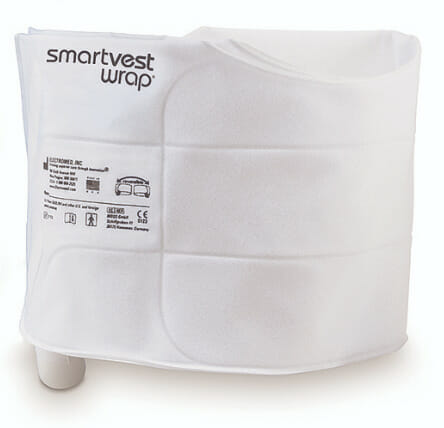
When treating patients for a respiratory condition, you want to provide the best, most comfortable experience possible.
If SmartVest is already a part of your hospital’s continuum of care program, then you can feel confident knowing that each patient will receive effective airway clearance treatment while in your care.
About SmartVest
The SmartVest Airway Clearance System is a high frequency chest wall oscillation (HFCWO) therapy device that works to deliver repeated pulses of air that gently squeeze and release the upper chest wall.
This process creates rapid air movement throughout the patient’s lungs while the frequent air oscillation helps thin, loosen, and propel mucus upward. This allows patients to cough out mucus more easily—thereby helping to prevent further infection caused by mucus buildup.
Respiratory Vest Therapy in Hospital Settings
Whether your patient is living with bronchiectasis, COPD (chronic obstructive pulmonary disease), cystic fibrosis, or any compromised respiratory condition, airway clearance may provide the best defense against mucus buildup, shortness of breath, flare ups, and other chronic symptoms.
SmartVest is designed to provide patients airway clearance therapy at home—as part of their long-term treatment plan—and we offer the same HFCWO therapy designed specifically for hospital use. In this article, you’ll find helpful visuals, instructions, and a video tutorial on how to introduce the SmartVest Wrap® to patients in a hospital setting.
 SmartVest Single-Patient-Use Wrap
SmartVest Single-Patient-Use Wrap
The single-patient-use wrap is a soft, breathable material that wraps around the patient’s chest wall, using Velcro®-like closures, and provides full 360° coverage.
Patients may wear the wrap while sitting up or laying down. It includes a single hose connection to be placed on either side of the patient’s bed, connecting to the SmartVest generator that sits on top of an easy-to-use pedestal.
Both the single-patient-use wrap and the SmartVest garment that is used at home, deliver the same 360° degree chest coverage. Each is equally designed to provide added comfort [1] during therapy—never restricting the patient’s ability to breathe.
SmartVest Wrap Features
Providing care to a patient in a hospital setting is much different from outpatient care. Patients are often in discomfort, with limited mobility, and may be recovering from a respiratory infection.
To help healthcare teams overcome these challenges, the single-patient-use wrap provides the following features:

Reversible
The wrap allows care teams to easily connect the hose on either side of the patient’s bed by simply reversing the wrap so it can easily connect to the SmartVest generator, which sits on top of a wheeled pedestal. This means less maneuvering around or needing to move hospital equipment, which can be cumbersome and cause discomfort to the patient.

Adjustable
The single-patient-use wrap with Velcro-like closures allows care teams to comfortably secure the wrap around each patient’s chest.

Supports Bronchial Drainage
The single-patient-use wrap delivers simultaneous HFCWO therapy to all lobes of the lungs to efficiently loosen and mobilize secretions.

Single-Patient-Use
The wrap is designed to be used by a single patient. This helps prevent the spread of germs or illnesses.
Using SmartVest’s Single-Patient-Use Wrap
When your patient is ready to receive airway clearance therapy in a hospital setting, you’ll be able to help them put on the wrap while sitting in bed. You’ll first need to ask your patient if they prefer to sit upright or lay down during therapy.
For the upright position
You will unfold the wrap and have the patient lean forward while sitting. This will allow you to gently place the back of the wrap behind the patient. Wrap the material around the chest wall, using the Velcro-like closures, to secure the wrap in front.
Because the closure is reversible, you can have the hose connection placed on either side of the patient.
The wrap should feel secure but not restricting. If it feels too tight, you may need to readjust the wrapping until the patient feels more comfortable.
For the laying down position
Ask the patient to turn on one side, so you’re able to place the wrap down flat underneath his or her body. Ask the patient to turn to the opposite side, so you can roll the remainder of the wrap out on that side, as well. Have the patient lay down on his or her back again, with each opening of the Velcro-like closure located at each side of the body.
As you did for the upright position, wrap the material around the chest wall so that it is secure but not restricting.
Connecting the Single Hose
As with the in-home SmartVest garment, the single-patient-use wrap includes an insertion point for a hose to connect from the wrap to the generator. Using one hand, hold the wrap in place and use the other to gently insert the end of the hose. Give it a slight twist but don’t force it in.
Setting the Generator for Patient Comfort
When titrating your patient’s SmartVest therapy, always begin at a low setting. The “manual” setting is the preferred mode of choice during hospital use, as this allows for easy titration of settings.
For speed, you want it around 6-10 hertz. For strength, you want the device set at around 15-25% pressure.
The patient will begin to feel the wrap inflate and it will begin to oscillate, providing 360° degree coverage. Ask the patient how he or she is feeling and listen for any vibrations in his or her voice. You might ask the patient to say an “ah” sound in order to hear this more clearly.
Continue to do this as you increase the settings. The vibration or bounce in the patient’s voice is a key indicator that he or she is receiving adequate therapeutic pressure on the chest wall. Always remember that the setting should be therapeutic yet comfortable, so if patients complain of too much pressure, lower the settings until they reach a desired strength that still produces vibrations in his or her voice.

Watch Our Video Tutorial!
For a visual representation of using our single-patient-use wrap in a hospital setting, watch our video and remember to subscribe to our YouTube channel for other helpful tutorials and insights from renowned pulmonologists.
After Hospital Use
From hospital to home, if your administration would like to benefit from incorporating SmartVest into your continuum of care program, we can help you get started.
Once you prescribe SmartVest for a patient at discharge, our team works diligently to process the reimbursement and prepare each device for shipment to be delivered right to the patient’s home.
Once the SmartVest system is delivered to their home, your patient will have an appointment to meet with a Registered Respiratory Therapist for a scheduled training session. During this training, your patient will learn how to operate SmartVest independently, thereby promoting greater patient adherence to therapy.
To learn more about how inpatient vest therapy can benefit your hospital, contact our support team today. We’ll partner with your hospital care team to design a custom plan that helps streamline your prescription process and provides patients with an easy-to-use airway clearance device.
Call us at 800.462.1045 to get started with SmartVest!
Resources
[1] Pokorney J. Comparison of Oscillatory Trough Pressure Generated by High Frequency Chest Wall Oscillation (HFCWO) Systems: A White Paper.
